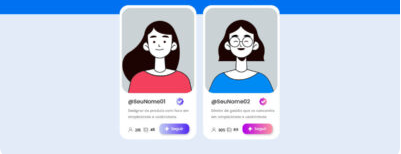Learn what storytelling with a sales focus is and check out the best tips to apply the strategy with your agency’s clients.
For companies that want to sell more without relying solely on promotions or a more invasive approach, storytelling with a sales focus is a strategy that offers more security and sustainability in the long term.
This is because, instead of working with loose messages, you organize them as a story with someone facing a real problem, a painful conflict, a turning point pointing to a solution, and an ending where the purchase makes sense.
Next, you’ll better understand what this concept is, see a practical structure and examples of applications by channel, such as social networks, landing pages, and email. Let’s go.
What is storytelling with a sales focus?
Simply put, storytelling is the art of conveying ideas in the form of engaging narratives.
From there, storytelling for sales takes this logic to the commercial journey. That is, you create a plot that helps the potential customer to recognize their own pain, see a path, and, in the end, act with confidence when acquiring the product or service.
But why does this strategy work so well? Because stories are usually easier to remember and generate empathy with the audience.
That is, instead of just saying that our platform is fast, you show the before and after in the customer’s life and still reinforce the message with a social proof..
In fact, the result often appears at various points in the funnel since:
- it generates more attention in the initial interactions at the top,
- more quality in opportunities in the middle,
- and less friction in the decision-making at the bottom.
Therefore, for an agency, this translates into content that speaks the client’s language and generates greater identification throughout the purchase process.

Structure of a good storytelling with a sales focus
But before getting into practice, it’s worth aligning the logic behind this sequence.
After all, the idea is to guide the reader through a natural path from pain recognition to decision-making without the transitions feeling forced from one stage to another.
Below you will find a step-by-step guide that your team can use in campaigns, pages, emails, and presentations.
| 1 Hook: Capture attention | Start with a situation that your ICP immediately recognizes. This way, you create a connection in seconds and give the reason for the person to continue reading or watching. | How to apply Use everyday scenes, numbers that surprise, or questions that expose the audience’s most common frustration. This starting point sets the stage to introduce the character. |
| 2 Character: Generate identification | Next, present someone who mirrors your audience—a typical customer with a position, routine, and clear goals. This helps the reader see themselves in the story. | How to apply Detail one or two relevant characteristics, like a lean team or aggressive ROAS goal, to provide credibility without being too lengthy. From here, you’re ready to lay out the conflict. |
| 3 Conflict: Make the pain explicit | Now make it clear what’s at stake. Lost time? Wasted money? Threatened reputation? The more concrete, the better. | How to apply Connect the pain with visible consequences—rework, delays, compromised goals. This tension opens up space for the turnaround without seeming like an abrupt change of subject. |
| 4 Turnaround: Point out the path | Introduce your solution as a guide, not the heroine of the story. Show the ‘how’ in a simple and progressive manner, reducing the perceived risk. | How to apply Describe a mini step-by-step—onboarding, initial configurations, everyday use. With the path clear, the audience will be more receptive to the proof. |
| 5 Proof: Provide assurance | It’s time to uphold the promise. Data, testimonials, relevant integrations, security seals, and before-after comparisons reduce objections. | How to apply Prioritize an objective metric and a short testimonial with context, segment, size, and scenario. The proof prepares the vision of the future with credibility. |
| 6 Future vision: Outline the aftermath | Show how the routine looks when the solution actually comes into play. It’s time to translate the benefit into a mental image. | How to apply Describe the day-to-day with action verbs—streamline, eliminate, simplify—and connect to tangible gains like time, revenue, predictability. This final picture paves the way for the call to action. |
| 7 Single and clear CTA: Invite to action | Finally, invite the person to a specific next step that aligns with the funnel stage. A primary CTA avoids dispersion and increases the click rate. | How to apply Make the CTA visible, direct, and consistent with the presented promise. If you include a secondary CTA like ‘Learn more,’ keep it discreet to avoid competing with the main objective. |
Tips for emotional triggers
Furthermore, to strengthen the decision without resorting to appeals, use triggers responsibly and transparently.
After all, they work as accelerators of the narrative as long as they make sense for the context. Among the main ones, we can highlight:
- Belonging, which reduces the feeling of being alone and signals that the choice is common among peers. Example: More than 1200 companies in your segment are already using it.
- Authority, lends credibility from recognized sources and reduces perceived risk. Example: Recommended by leaders of market X.
- Urgency, helps prioritize the decision when there are concrete windows. But avoid creating artificial urgency to not break trust. Example: announcements of schedules or limited stock when it is true.
- Social proof, shows results beyond the brand’s discourse and answers the question does it work for people like me? For this, use case NPS, and reviews.
When the narrative line is respected and you know how to use the triggers properly, storytelling with a sales focus is no longer just a story and becomes a predictable tool for moving leads through the funnel with less friction from the first contact to the closure.
Practical applications of the strategy
However, before going out and producing posts, pages, and other content, it’s worth remembering that the same story changes the way it’s told depending on the channel.
Thus, the objective is to maintain the plot that goes from pain to action but adjust the pace, format, and CTA for each context.
Next, see how to apply storytelling with a sales focus in social networks, landing pages, and email marketing, respecting the stages of the sales funnel.
Social networks: discovery and consideration
On social networks, attention is short. Therefore, the ideal is to tell the narrative in quick chapters that lead to a single invitation.
For example, in posts in carousel format, follow the sequence of
- pain,
- consequence,
- discovery,
- solution,
- proof,
- CTA..
In reels and stories, quickly show the pain, scene 1; the frustrated attempt, scene 2; and what changed with your product, scene 3.
Then, finish with a clear CTA. To tie the narrative together, use objective captions, link stickers, and text overlays that reinforce the action.
Lastly, use the customer’s voice— phrases they would say; keep transitions clear between slides; thus, afterward, as a result, and align the CTA to the stage at the top, invite for content. Later, direct to test or demo.
Landing pages: consideration and decision
Landing pages are widely used by agencies to capture leads that may become clients. Therefore, utilizing storytelling with a sales focus in these pieces is also important.
Below, check out some tips to help with more strategic production.
- Position the transformation, not the product. Instead of starting with the solution’s features, begin with the change the visitor wants to see. Close deals 2x faster. Then connect this promise to a brief proof to increase confidence from the first second.
- Pain section with customer language. liste três dores que sua persona realmente sente e, para ficar natural, traga a forma como ela fala. Isso cria continuidade com o anúncio/post que trouxe a pessoa até ali e prepara a apresentação da solução;
- Demonstrate the path, not just the product. Show how the solution removes friction and explain the initial step-by-step, such as connecting, mapping, automating, as this reduces perceived risk and leads the visitor to the next section.
- Proofs and objection reduction. Include cases with context, sector, or size of the company, testimonials, relevant integrations, and guarantees (free trial). This way, you connect emotion and reason—the story inspires, the numbers confirm, and the guarantee removes the fear of clicking.
- Visible, consistent CTA without internal competition. Define a main CTA, e.g., Schedule demo, and a more informative secondary one, e.g., See plans. Repeat the main one at strategic points on the page and keep text that reinforces the value to facilitate the decision.
Email marketing: nurturing and activation.
In emails, you can work with flows that aim to nurture and engage leads so that they move down the sales funnel. See an example of how to do this in three steps.
- Email 1: The problem no one talks about. To begin, tell a brief story that makes the pain explicit and then offer content that delves deeper into the theme. This will help in problem recognition and open dialogue.
- Email 2: Client turnaround. Bring a mini-case with numbers and a short quote to generate social validation and reduce potential objections.
- Email 3: Let’s go to the next step. por fim, conecte explicitamente a dor narrada ao caminho oferecido e proponha uma conversa, demo ou teste.
To seamlessly thread the sequence, use connectors between emails: after this guide, based on the previous case, segment by interest/behavior and adjust the CTA to the lead’s stage.
This way, each email supports the previous one and prepares the next, avoiding loose messages.
It’s worth reinforcing that in all channels, the logic is the same: pain, consequence, turnaround, proof, action. However, the rhythm and the way of telling stories change.
When these pieces connect, the reader understands the path, sees the value, and feels secure to take the next step.
In other words, your storytelling goes beyond being just beautiful and becomes a selling tool without losing humanity in the process.
Storytelling for sales: B2B vs B2C
If you work with clients from different segments, it’s important to highlight that the story that convinces in B2B doesn’t always work the same way in B2C.
This is because, although the basic structure is similar, the pace, type of evidence, and CTA change according to the decision-making context.
For example, in B2B, cycles tend to be longer, with more decision-making processes and greater perceived risk,
Thus, the narrative should highlight business impact and can speak to multiple personas, and should present robust evidence that the solution is really ideal for that company.
Meanwhile, in B2C, the decision is usually faster and more emotional. Therefore, focus on aspirations, quality of life, and small victories that can change the consumer’s life.
Including visual content and UGC (user-generated content) can weigh more throughout this purchase journey.
Attention to errors that may reduce conversion.
Even with a good story, small execution slips can hinder the conversion rate.
Thus, to keep the narrative clear and persuasive from start to finish, it is worth observing some critical points such as:
- Placing the brand as the heroine, when the brand takes center stage, the audience may lose identification. Therefore, reposition the focus on the character—your client—and the obstacles they face. This way, your solution appears as the map that simplifies the journey, not as the savior of the story.
- Promising without proving. The narrative can be emotional, but without evidence, the decision stalls. Therefore, complement promises with numbers, testimonials, and before-after comparisons to reduce perceived risk.
- Multiple CTAs. Several competing calls-to-action create doubt. Therefore, define one objective per piece and guide the audience to it. This way, attention doesn’t disperse, and conversion tends to rise.
- Excessive jargon. Technical terms can sound like barriers. So, prefer clear language. When inevitable, provide a short explanation to keep everyone on the same page.
- Long story for a short channel. In feeds and ads, attention is limited. So, prioritize small stories with a single conflict and a clear turnaround. On pages and presentations, delve deeper with proofs and details.
- Generic promises. Vague statements don’t say much. Therefore, specify the benefit and when it occurs. This makes the proposal tangible and comparable.
Finally, notice how all the points above connect when the client is the protagonist—the proof sustains the promise, the CTA guides the next action, and the language facilitates understanding on the right channel.
By eliminating these noises, you keep the narrative fluid, increase confidence, and create the ideal scenario for the decision. In other words, the story remains captivating but now it is also a seller.
Take the opportunity to also read How to present a report using good storytelling to present metrics.
FAQ: Storytelling with a sales focus.
To wrap up, we’ve gathered quick answers to common questions about the storytelling strategy for sales. Check it out:
It works when the story reflects the persona’s real pain and brings relevant proof. The adjustment lies in the vocabulary, examples, and type of evidence.
Track CTR, time on page, email responses, CRM stage advancement, proposal acceptance rate, and conversion. Also, compare narratives with pieces without stories.
Video helps but is not mandatory. Pieces in carousel format, email, and landing pages with a good sequence—hook, conflict, turnaround, proof, CTA—perform very well.
Yes, as long as it matches the brand and audience. But in B2B strategies, prefer subtle humor and day-to-day situations of the persona.
In the proof section. Insert before the CTA with context, client profile, challenge, result, and numbers.
Use market benchmarks, certifications, and partnerships, and offer reverse risk (free trial or guarantee). In parallel, gather your first cases.
Create a playbook with the above structure, a library of hooks, mapped objections, and examples by channel. Also, conduct weekly reviews aiming for clarity, proof, and CTA.



